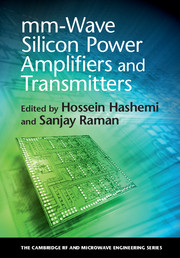Book contents
- Frontmatter
- Contents
- List of Contributors
- Preface
- 1 Introduction
- 2 Characteristics, performance, modeling, and reliability of SiGe HBT technologies for mm-wave power amplifiers
- 3 Characteristics, performance, modeling, and reliability of CMOS technologies for mm-wave power amplifiers
- 4 Linear-mode mm-wave silicon power amplifiers
- 5 Switch-mode mm-wave silicon power amplifiers
- 6 Stacked-transistor mm-wave power amplifiers
- 7 On-chip power-combining techniques for mm-wave silicon power amplifiers
- 8 Outphasing mm-wave silicon transmitters
- 9 Digital mm-wave silicon transmitters
- 10 System-on-a-chip mm-wave silicon transmitters
- 11 Self-healing for silicon-based mm-wave power amplifiers
- Index
- References
11 - Self-healing for silicon-based mm-wave power amplifiers
Published online by Cambridge University Press: 05 April 2016
- Frontmatter
- Contents
- List of Contributors
- Preface
- 1 Introduction
- 2 Characteristics, performance, modeling, and reliability of SiGe HBT technologies for mm-wave power amplifiers
- 3 Characteristics, performance, modeling, and reliability of CMOS technologies for mm-wave power amplifiers
- 4 Linear-mode mm-wave silicon power amplifiers
- 5 Switch-mode mm-wave silicon power amplifiers
- 6 Stacked-transistor mm-wave power amplifiers
- 7 On-chip power-combining techniques for mm-wave silicon power amplifiers
- 8 Outphasing mm-wave silicon transmitters
- 9 Digital mm-wave silicon transmitters
- 10 System-on-a-chip mm-wave silicon transmitters
- 11 Self-healing for silicon-based mm-wave power amplifiers
- Index
- References
Summary
Background
Motivation for self-healing
The rise of digital computation and personal computing has led to continual advances in semiconductor technologies at an exponential pace, following Moore's Law. In each successive processing node, the minimum feature size decreases, improving performance, but also bringing some trade-offs in terms of variation between chips as well as between transistors on the same chip [1–4]. One major source of this variation is random dopant fluctuations (RDFs) in the channel of a transistor [5, 6]. A typical 130-nm complementary metal–oxide–silicon (CMOS) process will have several hundreds of dopant atoms in the channel region. In contrast, in a 32-nm process, only a few tens of dopants control important transistor characteristics like threshold voltage, etc. A second source of variation is line-width control in these advanced processes. Line-edge roughness (LER) caused by lithographic and etching steps directly impacts the overlap capacitances as well as other device parameters like drain-induced barrier lowering (DIBL) and threshold voltage [7]. Figure 11.1 shows how threshold voltage variations scale with process technology node. As can be seen, the variation is much more manageable at larger nodes, and the variation is expected to continue to increase at smaller nodes as the total number of dopant atoms as well as the channel length reduces even further. If the variation can be dealt with, however, the smaller transistors can enable new applications for mm-wave power generation, enabling transmitters and amplifiers at higher frequencies, powers, and efficiencies. Another issue that analog designers face is that, due to the digital processing market being the driving force pushing the scaling, the models provided by the foundries early in the node's development stage are primarily designed for digital use, and are often not reliable at mm-wave frequencies.
In addition to these static sources of variation, dynamic temperature variations across the same die can give rise to varying sub-threshold leakage, supply voltage variations thereby directly affecting overall system performance. Variability in operating environment of power generation systems can adversely affect their performance. This comes in the form of temperature variation, degradation due to aging [8], and, in the case of power amplifiers that are driving antennas, load impedance mismatch caused by voltage standing wave ratio (VSWR) events [9] that occur when objects in the environment interactin the near field of the antenna, as can be seen in Fig. 11.2.
- Type
- Chapter
- Information
- mm-Wave Silicon Power Amplifiers and Transmitters , pp. 419 - 456Publisher: Cambridge University PressPrint publication year: 2016



